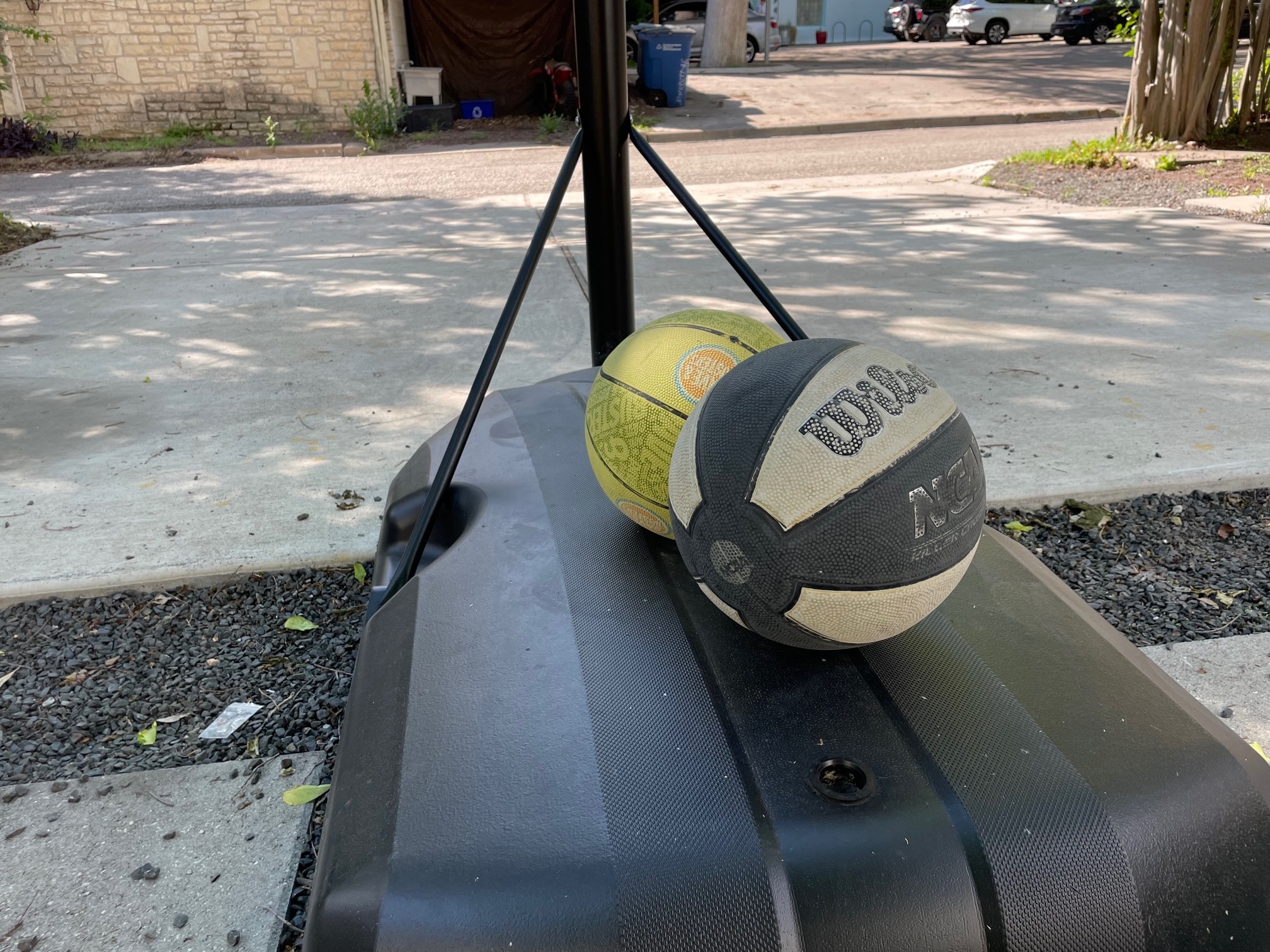A few months ago, a group of us neighbors-turned-friends bought a basketball hoop. It has a plastic base weighted down by water, two little wheels for portability, a clear backboard which can be adjusted to heights between seven and 10 feet, and a bright orange rim that's subtly egg-shaped from when the hoop tipped over during assembly. It sits on the gentle slope of the driveway behind the duplex where my sister lives. Every so often we roll it out into the side street, forming a court between the curb and the entrance to the parking lot of a dog-grooming business. Mostly, though, we just mill around in the driveway, shooting hoops and the shit, not necessarily in that order.
Sometimes a flare will go up in the group text: “Bball?” But the basketball hoop functions best like an office water cooler—a place to go to see who’s around to hang. Alex and I live three blocks away from the hoop and when we walk past Beth’s house we always listen for the sound of a ball smacking the pavement, craning our necks as we round the corner to see if anyone is out there. A little while ago we were walking to dinner and Beth’s boyfriend, who had been out of town for a few weeks, was in the back getting up some jumpers. We cheered, swung down the street, and caught up over the course of a game of PIG, laughing at funny anecdotes and trick shots. Then we were on the way to the restaurant again, just a little sweatier. The hoop is a reminder as much as an invitation. You’ve got time for a quick game of something.
Much has been made recently about the loneliness crisis and how people should hang out more and how people should have more sex and how everyone should just stop being losers and have more fun, dammit. I don’t think these takes are necessarily wrong, but lately I’ve been thinking about what conditions would need to exist to make these human interactions more possible for more people. Yes, individuals need to have a willingness to engage with others, but where does this willingness come from? Isn't it clear that a degree of that willingness is connected to having time and energy and at least a baseline sense of belonging?
Beth and I grew up in a cul-de-sac with five other houses, all full of kids around our age. There were five girls and six boys in our little cohort, which didn't include the rotating cast of kids from the rest of our white upper-middle-class neighborhood. The cul-de-sac, which we called the court, was our water cooler. We’d flock out our front doors every day, dividing ourselves up to play street hockey and kickball, tennis-baseball and 500, and, when we were still too little to do real damage to each other, keep away. (Initially, this game was called “smear the queer” until someone suggested a name change.) Spread out between the houses, we had baseball gloves, lacrosse sticks, and some beat-up old golf clubs none of us knew how to use. And of course, we had a basketball hoop. Actually, the court had two: a 10-foot hoop in front of our house, a Christmas present for our older brothers when Beth and I were still toddlers, and one at the foot of our next-door neighbors’ driveway, which was, crucially, adjustable. We played for hours on that latter hoop, stopping only when someone got hurt and we had to assess whether it was bad enough to get parents involved, or when someone had run inside to pee. We played two-on-two and around the world and PIG and HORSE and PENIS. And we played knockout.
These knockout games, as I remember, were especially fun. Everyone wanted to play so they had the air of an all-star game. The line to shoot would stretch halfway across the court. The eliminated players would cheer or boo based on which one had knocked them out. Quibbles about rules or player conduct were adjudicated by the scrum. Every game was a fresh opportunity. My opinion of the game remains unchanged: It's fun as hell.
On one recent Sunday afternoon, when a group of us had been playing for a while, we tweaked the game such that the first shot had to be tossed underhand, grampy-style. (In some other previous game, we half-seriously started calling this shot “grampy," as opposed to "granny," and it stuck. Wokeness wins again!) No rules were specified for the rebounded shots, but a few purists insisted on doing only underhanded shots. By the end of the round, we were howling at their various grampy layup efforts.
The hoop in my sister’s backyard has been reminding me of the sheer genius of the world's best driveway basketball game, but it's also made me think about the mundane joy of spontaneously goofing around with your pals. I consider myself very fortunate in love and friendship and goofing, but I know what it is to feel lonely and overwhelmed and withdrawn. I think telling people who are run down by their jobs or family obligations, or who are otherwise alienated from others (rich people can be alienated too), that they just need to hang out more is like telling an anxious person they need to relax—and similarly ineffective. I think it’s worthwhile to ask what we can do together to create an environment in which people are able to spend time with each other doing nothing of "value." As artist and writer Jenny Odell wrote in her book How To Do Nothing, doing nothing can be read as a political act.
... beyond self-care and the ability to (really) listen, the practice of doing nothing has something broader to offer us: an antidote to the rhetoric of growth. In the context of health and ecology, things that grow unchecked are often considered parasitic or cancerous. Yet we inhabit a culture that privileges novelty and growth over the cyclical and the regenerative.
Awareness, as Odell wrote, "is the seed of responsibility." That responsibility can't be fully understood without a structural critique. In her book The Problem With Work, professor and theorist Kathi Weeks develops an anti-work argument that politicizes work, family, and leisure. In a 2018 interview, she said:
If we include leisure in our conception of work, as the time we spend recovering from work or compensating for the damage it does, then the refusal of work would require as well the refusal of consumerist practices and values and a more radical reimaging of what more "free" time might enable.
What's being obscured when the onus for solving the problem of loneliness is placed squarely on individuals and their (in)ability to get involved? How might we rearrange the structures and rhythms of our personal and collective lives for a different kind of sociality? The arrival of the basketball hoop definitely did not result from thinking about these questions—I’m pretty sure the hoop was a drunken idea that stumbled into fruition—but it might help point to some answers anyway.






